
I spend a lot of time with startups, and a good portion of that time helping them think through organizational questions. One of the most common questions I get from growing startups is, what’s the ideal ratio of engineers to product managers? (A different kind of P/E ratio.)
For fun, I put the question to Twitter. I deliberately didn’t specify the industry or company stage because I wanted to see how my followers interpreted it. I got more than 50 different responses. As smart product managers, most of the answers were variations of “it depends.” It’s usually my answer too. What does it depend on?
- Number of product surfaces: I encourage companies to organize their product team around customers, not code repositories. The number of PMs is dictated by the number of product surfaces. For example, a company with a single consumer mobile app has different needs than a multi-sided marketplace. When I use the term “product surfaces,” I don’t only mean customer-facing UIs. An API, a billing system, and an internal customer support tool may all be distinct surfaces worthy of PMs.
- How hands-on the Product CEO/Founder is: Before the company has found product/market fit, one of the founders should be the day-to-day product manager (I call this person Product Manager Zero).
- How experienced the product managers are: More experienced PMs can lead larger teams whereas junior PMs need more day-to-day supervision and mentoring. If you’re hiring early career PMs, make sure your organization can ensure their success. That means a more experienced product leader to provide mentorship. Startups sometimes make the mistake of stacking the organization with lots of junior (and cheaper) developers and product managers before the company is able to support them.
- Stage of the product: Bigger companies with mature products have different needs than startups looking for product/market fit. Also, as the product evolves you begin to need PM coverage for product areas not directly aligning with customers, for example in growth, platforms, spam and abuse, and the like.

A significant majority of the tweets recommended something in the range of 5-9 software developers for every 1 PM. There were reasons why people recommended going higher or lower, but it seems to be a sweet spot. Thinking back on my own experience, my highest-performing teams also fell within that range. Interestingly, it’s the Magical Number 7, Plus or Minus 2, made famous by cognitive psychologist George Miller in an influential 1956 paper. You’ll find lots of people arguing for similar-sized teams, including Jeff Bezos, who famously advocates for “Two Pizza” teams.
In most cases, having too few PMs is better than too many: it forces difficult trade-offs, streamlines decision-making, and avoids randomizing the engineers. When it comes to designers, I’ve preferred a ratio of 1:1 with PMs for user-facing product surfaces. Product teams work best when the dedicated triad of PM, designer, and tech lead form the core.
What’s your ideal ratio?
